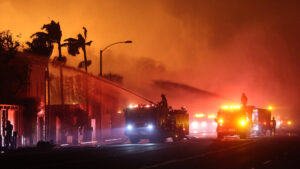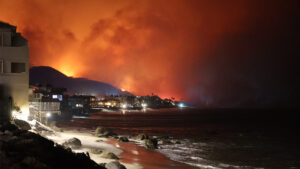By Gary W. Yohe, Wesleyan University
The devastating wildfires in Los Angeles have made one threat very clear: Climate change is undermining the insurance systems American homeowners rely on to protect themselves from catastrophes. This breakdown is starting to become painfully clear as families and communities struggle to rebuild.
But another threat remains less recognized: This collapse could pose a threat to the stability of financial markets well beyond the scope of the fires.
It’s been widely accepted for more than a decade that humanity has three choices when it comes to responding to climate risks: adapt, abate or suffer. As an expert in economics and the environment, I know that some degree of suffering is inevitable — after all, humans have already raised the average global temperature by 1.6 degrees Celsius, or 2.9 degrees Fahrenheit. That’s why it’s so important to have functioning insurance markets.
While insurance companies are often cast as villains, when the system works well, insurers play an important role in improving social welfare. When an insurer sets premiums that accurately reflect and communicate risk — what economists call “actuarially fair insurance” — that helps people share risk efficiently, leaving every individual safer and society better off.
But the scale and intensity of the Southern California fires — linked in part to climate change, including record-high global temperatures in 2023 and again in 2024 — has brought a big problem into focus: In a world impacted by increasing climate risk, traditional insurance models no longer apply.
How climate change broke insurance
Historically, the insurance system has worked by relying on experts who study records of past events to estimate how likely it is that a covered event might happen. They then use this information to determine how much to charge a given policyholder. This is called “pricing the risk.”

When Americans try to borrow money to buy a home, they expect that mortgage lenders will make them purchase and maintain a certain level of homeowners insurance coverage, even if they chose to self-insure against unlikely additional losses. But thanks to climate change, risks are increasingly difficult to measure, and costs are increasingly catastrophic. It seems clear to me that a new paradigm is needed.
California provided the beginnings of such a paradigm with its Fair Access to Insurance program, known as FAIR. When it was created in 1968, its authors expected that it would provide insurance coverage for the few owners who were unable to get normal policies because they faced special risks from exposure to unusual weather and local climates.
But the program’s coverage is capped at $500,000 per property – well below the losses that thousands of Los Angeles residents are experiencing right now. Total losses from the wildfires’ first week alone are estimated to exceed $250 billion.
How insurance could break the economy
This state of affairs isn’t just dangerous for homeowners and communities — it could create widespread financial instability. And it’s not just me making this point. For the past several years, central bankers at home and abroad have raised similar concerns. So let’s talk about the risks of large-scale financial contagion.
Anyone who remembers the Great Recession of 2007-2009 knows that seemingly localized problems can snowball.
In that event, the value of opaque bundles of real estate derivatives collapsed from artificial and unsustainable highs, leaving millions of mortgages around the U.S. “underwater.” These properties were no longer valued above owners’ mortgage liabilities, so their best choice was simply to walk away from the obligation to make their monthly payments.

Lenders were forced to foreclose, often at an enormous loss, and the collapse of real estate markets across the U.S. created a global recession that affected financial stability around the world.
Forewarned by that experience, the U.S. Federal Reserve Board wrote in 2020 that “features of climate change can also increase financial system vulnerabilities.” The central bank noted that uncertainty and disagreement about climate risks can lead to sudden declines in asset values, leaving people and businesses vulnerable.
At that time, the Fed had a specific climate-based example of a not-implausible contagion in mind – global risks from sudden large increases in global sea level rise over something like 20 years. A collapse of the West Antarctic Ice Sheet could create such an event, and coastlines around the world would not have enough time to adapt.
The Fed now has another scenario to consider – one that’s not hypothetical.
It recently put U.S. banks through “stress tests” to gauge their vulnerability to climate risks. In these exercises, the Fed asked member banks to respond to hypothetical but not-implausible climate-based contagion scenarios that would threaten the stability of the entire system.
We will now see if the plans borne of those stress tests can work in the face of enormous wildfires burning throughout an urban area that’s also a financial, cultural and entertainment center of the world.![]()
Gary W. Yohe is the Huffington Foundation professor of economics and environmental studies at Wesleyan University. Banner photo: The Eaton Fire in Los Angeles County in January (CAL FIRE, Public domain, via Wikimedia Commons).
This article is republished from The Conversation under a Creative Commons license. Read the original article.
Sign up for The Invading Sea newsletter by visiting here. To support The Invading Sea, click here to make a donation. If you are interested in submitting an opinion piece to The Invading Sea, email Editor Nathan Crabbe at nc*****@*au.edu.



